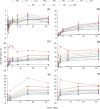The differential assimilation of nitrogen fertilizer compounds by soil microorganisms
- PMID: 38849295
- PMCID: PMC11223579
- DOI: 10.1093/femsle/fnae041
The differential assimilation of nitrogen fertilizer compounds by soil microorganisms
Abstract
The differential soil microbial assimilation of common nitrogen (N) fertilizer compounds into the soil organic N pool is revealed using novel compound-specific amino acid (AA) 15N-stable isotope probing. The incorporation of fertilizer 15N into individual AAs reflected the known biochemistry of N assimilation-e.g. 15N-labelled ammonium (15NH4+) was assimilated most quickly and to the greatest extent into glutamate. A maximum of 12.9% of applied 15NH4+, or 11.7% of 'retained' 15NH4+ (remaining in the soil) was assimilated into the total hydrolysable AA pool in the Rowden Moor soil. Incorporation was lowest in the Rowden Moor 15N-labelled nitrate (15NO3-) treatment, at 1.7% of applied 15N or 1.6% of retained 15N. Incorporation in the 15NH4+ and 15NO3- treatments in the Winterbourne Abbas soil, and the 15N-urea treatment in both soils was between 4.4% and 6.5% of applied 15N or 5.2% and 6.4% of retained 15N. This represents a key step in greater comprehension of the microbially mediated transformations of fertilizer N to organic N and contributes to a more complete picture of soil N-cycling. The approach also mechanistically links theoretical/pure culture derived biochemical expectations and bulk level fertilizer immobilization studies, bridging these different scales of understanding.
Keywords: 15N stable isotope tracing (SIP); amino acids; ammonium; immobilization; nitrate; urea.
© The Author(s) 2024. Published by Oxford University Press on behalf of FEMS.
Conflict of interest statement
None.
Figures



Similar articles
-
Nitrogen Fertilizer and Straw Applications Affect Uptake of 13C,15N-Glycine by Soil Microorganisms in Wheat Growth Stages.PLoS One. 2017 Jan 3;12(1):e0169016. doi: 10.1371/journal.pone.0169016. eCollection 2017. PLoS One. 2017. PMID: 28045989 Free PMC article.
-
Evaluation of methods to measure differential 15N labeling of soil and root N pools for studies of root exudation.Rapid Commun Mass Spectrom. 2004;18(20):2415-25. doi: 10.1002/rcm.1615. Rapid Commun Mass Spectrom. 2004. PMID: 15386635
-
Investigating bacterial coupled assimilation of fertilizer‑nitrogen and crop residue‑carbon in upland soils by DNA-qSIP.Sci Total Environ. 2022 Nov 1;845:157279. doi: 10.1016/j.scitotenv.2022.157279. Epub 2022 Jul 10. Sci Total Environ. 2022. PMID: 35830916
-
Nitrogen mineralization and assimilation at millimeter scales.Methods Enzymol. 2011;496:91-114. doi: 10.1016/B978-0-12-386489-5.00004-X. Methods Enzymol. 2011. PMID: 21514461 Review.
-
Plant nitrogen assimilation and its regulation: a complex puzzle with missing pieces.Curr Opin Plant Biol. 2015 Jun;25:115-22. doi: 10.1016/j.pbi.2015.05.010. Epub 2015 Jun 1. Curr Opin Plant Biol. 2015. PMID: 26037390 Review.
References
-
- Booth MS, Stark JM, Rastetter E. Controls on nitrogen cycling in terrestrial ecosystems: a synthetic analysis of literature data. Ecol Monogr. 2005;75:139–57.
-
- Bunch ND, Bernot MJ. Nitrate and ammonium uptake by natural stream sediment microbial communities in response to nutrient enrichment. Res Microbiol. 2012;163:137–41. - PubMed
-
- Černý J, Balík J, Pavlíková Det al. . The influence of organic and mineral nitrogen fertilisers on microbial biomass nitrogen and extractable organic nitrogen in long-term experiments with maize. Plant Soil Environ. 2003;49:560–4.
-
- Charteris AF, Knowles TDJ, Michaelides Ket al. . Compound-specific amino acid 15N stable isotope probing of nitrogen assimilation by the soil microbial biomass using gas chromatography/combustion/isotope ratio mass spectrometry. Rapid Commun Mass Spectrom. 2016;30:1846–56. 10.1002/rcm.7612. - DOI - PMC - PubMed
MeSH terms
Substances
Grants and funding
LinkOut - more resources
Full Text Sources
Miscellaneous

